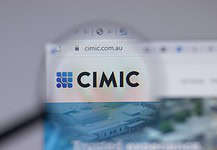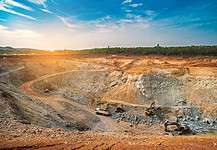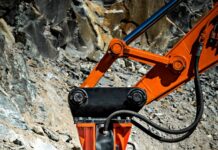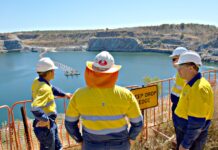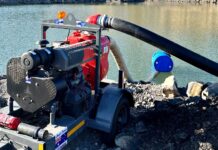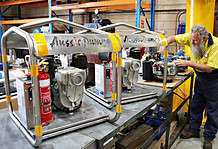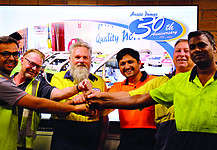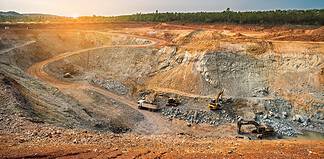In 1996 Stuart MacGregor designed what was to become central to an evolving and innovative series of anchored instrumentation.
A sixth-generation gold miner – and hoping his 19-year-old son is on his way to becoming the seventh generation – Stuart, the managing director and principal geotechnical engineer of SCT Operations, designed the first Rock-IT instrumentation with the effective and accurate measurement of ground movement in mind.
“In a former role, I spent a lot of time underground, and my job was to measure the ground moving, so this is where a lot of these ideas crystalised,” he said.
“When I joined SCT (Strata Control Technology) the coal industry didn’t have the experience in monitoring ground movement.
“These instruments are all designed in Australia, but we had to outsource the manufacturing to stay competitive.”
Initially manufactured in the UK, manufacturing of the instruments was later moved to an entirely SCT-owned facility in China.
“I am a bit of a control freak, so having the fully-owned facility in China was the only real way to ensure quality control,” Stuart said.
“Quality is a really important aspect because these are safety monitoring devices and to ensure that quality as well as the integrity of supply continuation, we had to take that level of control.”
Stuart said the instruments were all designed and manufactured to meet the harsh environment into which they would be deployed – with the anchors and rockets all made from 3-16 stainless steel.
Further, with every shipment which arrived back in Australia, there was a stringent testing regime which saw every box opened and every instrument checked and tested – all at a purpose-built warehouse based in Wollongong in NSW.
Routine instrumentation
The measurement of ground movement in the underground mining context is as vital as it is complex.
The SCT two and four anchor Rock-IT instruments are part of a routine suite which measures the movement of rock mass in an underground mining tunnel.
In installing these instruments, a hole can be bored into the tunnel, on any wall, including into the floor. This is enabled by the instruments’ configuration.
“Within them is a spring mechanism so you’re not just relying on gravity,” Stuart said.
“This means they can measure movement at any part of a tunnel.”
The Rock-IT works by embedding two or four anchors, sequentially placed at different linear depths along the length of a bore hole.
These anchors are attached to a T-piece of the instrument’s collar, and each will activate different indicators.
“We have a spring anchor at the bore hole, and you can see there is a collar piece that looks like a rocket, which anchors the collar piece and movement indicator at the edge of the tunnel – whether it is the wall, or the roof or floor,” Stuart said.
“Those springs, which are attached by stainless steel wires, then spring to anchors at various required depths and they are attached to movement indicators.
“Then, when the ground moves and when there is displacement, the springs move, and that displacement is captured by the movement indicators at the collar.”
The different depths of the anchors enable the gauging of the integrity of the tunnel and also enables the assessment of the rock mechanics and support elements needed.
“This enables an operator to monitor the instrument and determine, ‘At what point is my shorter support elements not working’,” Stuart said.
“So, in other words, my tunnel is unstable, and when and where do I needed to use deeper or longer support elements.”
This, Stuart said, is usually observed and acted upon in accordance with TARP – the Trigger Action Response Plan.
He gives an example: typically, with routine monitoring, there are predetermined sets of guidelines: so if is movement within the tunnel roof is less than 1mm, then the supports are working; but if it is more than 10mm of movement, then there is a need to put more support elements in.
“There is what we call a Hierarchy of Responses related to the different displacement,” he said.
The instruments enable stages within that hierarchy to be tangibly and visibly ranked – and, as needed, activated.
DIY Data in Situ
One of the more broadly appreciated aspects of the Rock-IT instruments was the ability for the workforce to utilise and understand the data. There is no need for a specialist to come and measure or analyse the data.
“The workforce loves it,” Stuart said.
“They themselves can come along and see there is something wrong or different with the ground.
“They can see it was a certain reading yesterday and it is much higher today.”
This makes the instrumentation usable by those who are most invested in the monitoring of factors such as this which have a direct impact on their safety; and according to the Hierarchy of Responses, if there is a difference, they can then get a statutory official or similar to intervene.
Stuart said there were varied levels of instrumentation which monitored conditions such as ground movement.
These were categorised into On-Shift instrumentation, which was a key requirement for those in situ and working in the conditions, Statutory Official, and Engineer. Each tier in the hierarchy ensured a structured approach which was clearly outlined in mine ground management plans.
Dials, Scales and Product Diversity
The variations in the range of instrumentation are aimed at meeting the diverse needs of the market.
Stuart said the clock faces held dual benefit, in that it was easier to read and also had a multiplier, which proved effective and useful, especially when the instrument was located on a high roof, or elsewhere which would be otherwise difficult to read.
He said the Clock-IT dials also had a mechanical advantage in that it was geared, and they had a lower displacement measurement range.
“Some will have maybe 10-20mm, but others will have a much broader displacement range,” he said.
“It’s horses for courses and you can tailor a specific measurement device for any different application and can use multiple different ones in close proximity if required.
“We have some mines which have a thousand or so of these operating.”
While the number might be vast, the location was an exact science, with nothing ad hoc about the placement of each instrument.
Located at predefined points, the instruments used would either be a Rock-IT or a Clock-IT and while there were some minor permeations, either the two or four anchor instruments would be applied and placed according to the specific instrument’s use and best placement.
Stuart said typically, these would be installed at a new development cycle, although they could also be installed somewhere which might be returned to in order to extract a stope, or, in a coal mine, to extract more ore.
Digital Transformation
Up until recently, SCT has focused on analogue instrumentation, but like organisations the world over, there was a strong focus on digitalisation and transformation.
Stuart said a strong presence in coal had led to SCT accessing the Australian Coal Association Research Program (ACARP) Industry-funded grant program to progress the development of their digital technology in the space of rock mechanics and strata control.
Upon the successful submission of a proposal to the fund, Stuart and his team were able to action a research program on digital instrumentation which manifested as a four-year project to develop wireless and Wi-fi compatible digital instruments.
“Some of this was to take the analogue instruments and make them digital, and then we also worked to develop new gear.”
It is here that what Stuart names the Smart Shear, was born.
“We have been working with the NZ – specifically in the Pike Rover Mine Disaster area – in the development of a real-time monitoring instrumentation which can be installed in tunnels with the data collected and stored in a cloud-based system,” he said.
At the moment, the system is hard wired – limitations of which are self-evident.
Analogue is, without doubt, cheap and cheerful, Stuart said, but the development of wireless and Wi-fi systems is the present goal.
The Holy Grail
The Holy Grail in this field, Stuart said, is the instrument you can stick into the ground and it talks to the world.
This is what the market wants, and for SCT, this will be a reality within the next 12 months, or so.
“By the middle of next year, we hope to have a digital range under the banner of ‘Smart’,” Stuart said.
“Data will be collected, and then information stored in a cloud-based repository. That will enable the building of trends and will see the potential for much larger data sets than are possible now.”
One of the biggest challenges is the collection and analysis of data in real time.
With the Smart Shear, new measures are being developed to constantly measure the displacement, as well as the shear, in the rock mass.
The real time monitoring can identify if there is a discontinuity or a fault plane that might not actually displace a lot but could shear and break.
Akin to an MRI or X-ray, the Smart Shear measures an absolute inclination, off which the relative displacement can be assessed. If there are a number of plots this would create a path of the profile of the rock mass.
Any displacement measured can then be determined to be within a “comfortable” range of movement or instability or otherwise.
It is here the data can be most effectively used to make informed decisions around the information captured by the Rock-ITs and Clock-ITs.
Of course, as with any cloud-based data system, the security of the network is of paramount importance.
“There is the security – and of course we don’t want any malicious attacks on the network – but we also don’t want to interfere with the production network driving autonomous and remote equipment,” Stuart said.
Stress Tests
The development of the SCT instruments has also enabled accurate and accessible stress measurement.
“Here, we come along to the site and drill a bore hole to measure the stress material properties, the deformability of it, and the load impacting on it,” Stuart said.
Even before mining commences, there is a level of stress evident in the ground.
When mining occurs, this stress field is modified and through this use of instrumentation, we can measure what those modifications are.
“Too much stress, means the will rock face will fail, with potentially catastrophic outcomes,” Stuart said.
Stuart said it was not only the local area of the tunnel, which needed to be measured and monitored, but other areas were critical also.
In stress testing, the process involves a hole being drilled into the area being measured, with a cell then placed at a prescribed depth. Once in place, the strain on the cell is gauged.
Then, using a technique called over-coring, bigger hole is drilled around the outside and this entire piece of rock, which still encases the stress measuring cell, is removed from the rock face.
This then relieves the stress on that piece of rock.
The stress of the rock face is then measured, using an equation involving the reading that the cell gave when the piece of rock was in the ground, compared to what the negative stress reading is on that same cell, when it is removed from the ground and the stress has been relieved.
“The technology has been around for quite a while, but we have developed our own cell and we now have a technology that enables us to do quite deep and difficult environments,” Stuart said.
“This enables us to test at up to 1000m in depth and it is three-dimensional testing.”
Stuart said this was a significant point of difference when compared to other similar technologies which provided data only on a two-dimensional basis.
He said the stress management field services had been deployed in works on the massive Snowy River 2.0 project, as well as in projects throughout Ecuador, Canada and throughout Australia.
“This has very significant capabilities and it is world leading technology,” Stuart said.
“There are quite a few more overseas deployments would be like to get to post COVID, as well.”
While Stuart concedes, ‘not everyone loves looking at rocks’, the SCT approach had always been about measuring and better understanding the behaviours of a rock mass to develop solutions.
Experienced Point of Difference
In developing those solutions, SCT’s geotechnical and engineering experience are what sets the organisation apart from others in the field.
From the learnings of first-hand experience and listening to the specific requirements, challenges and problems faced by clients, they have been able to develop means of being able to model the ground – and put into the model the information of stress and characteristics.
All the facets of the business work together – from the investigation program to the design of a package of work and then the development of instrumentation.
The instruments are developed to the highest standards, with the most stringent manufacturing controls via a diversely skilled team of civil engineers, petroleum engineers, mechanical engineers, rock mechanics engineers, geologists, and technicians.
“Together, in SCT, we have a collective experience of more than 300 years. We have people with us who have been with the company since it started in 1989,” Stuart said.
“Some of what we do is as a response to a need, and we build an instrument to meet that need.
“But what we are also doing now, is building the next generation of our instrumentation.”
SOURCE
SCT Operations Pty Ltd
P 02 4222 2777
E [email protected]
W www.sct.gs



